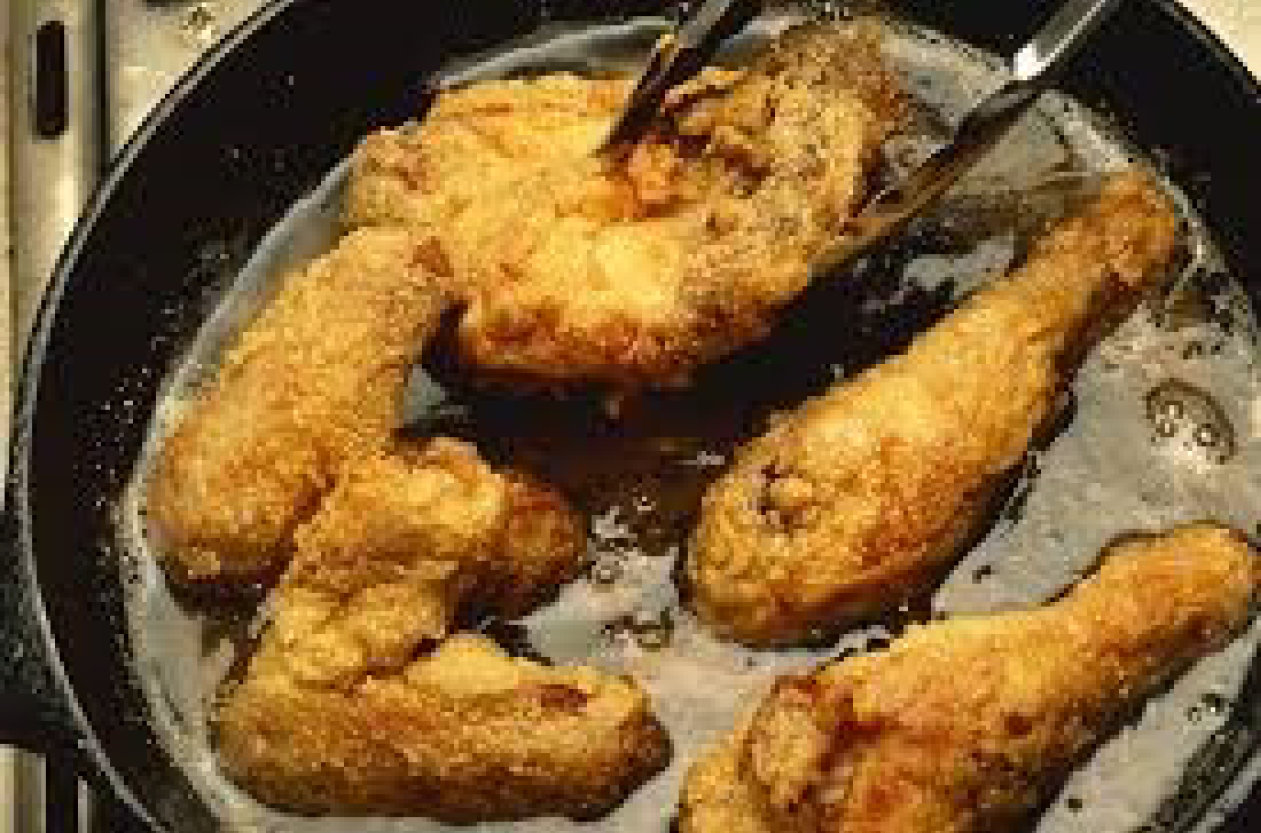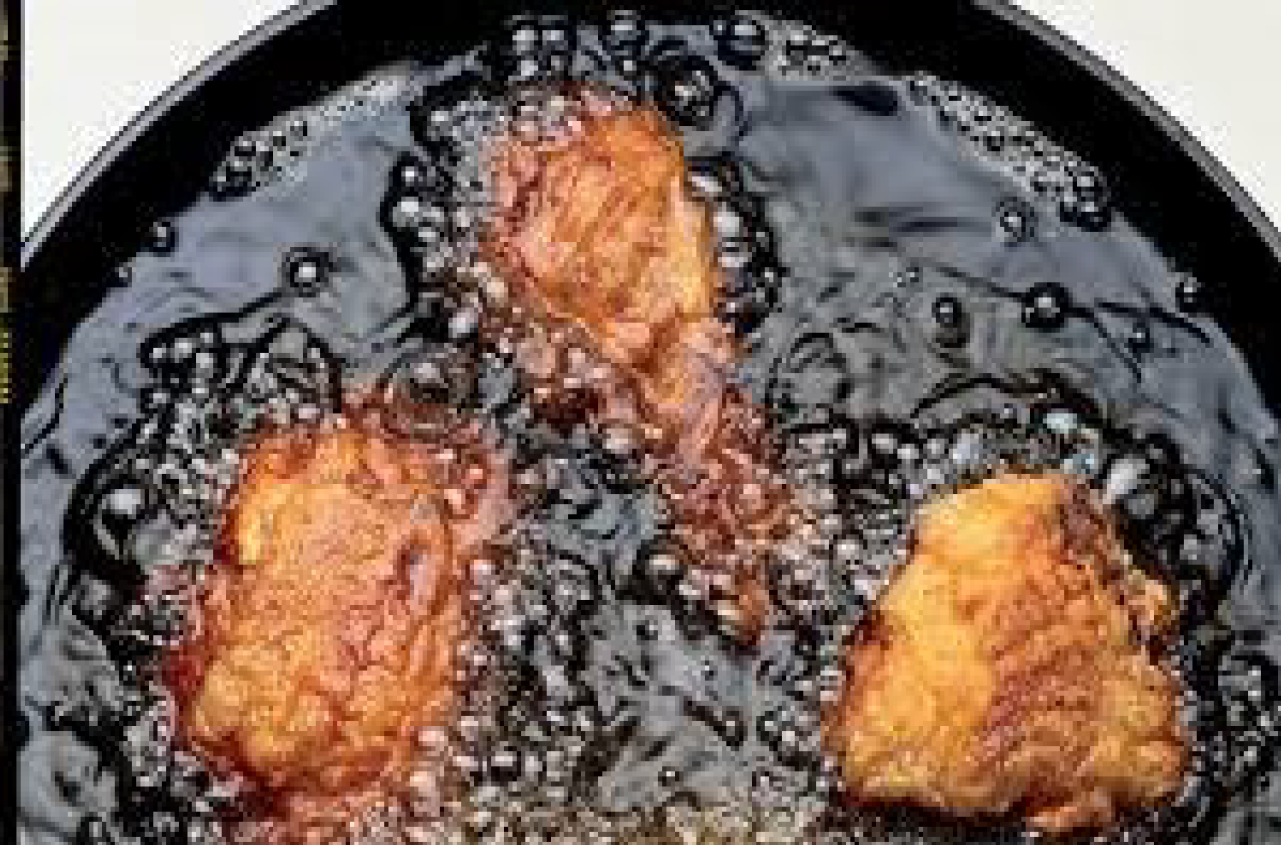8.1: Frying Methods
- Page ID
- 21862
\( \newcommand{\vecs}[1]{\overset { \scriptstyle \rightharpoonup} {\mathbf{#1}} } \)
\( \newcommand{\vecd}[1]{\overset{-\!-\!\rightharpoonup}{\vphantom{a}\smash {#1}}} \)
\( \newcommand{\id}{\mathrm{id}}\) \( \newcommand{\Span}{\mathrm{span}}\)
( \newcommand{\kernel}{\mathrm{null}\,}\) \( \newcommand{\range}{\mathrm{range}\,}\)
\( \newcommand{\RealPart}{\mathrm{Re}}\) \( \newcommand{\ImaginaryPart}{\mathrm{Im}}\)
\( \newcommand{\Argument}{\mathrm{Arg}}\) \( \newcommand{\norm}[1]{\| #1 \|}\)
\( \newcommand{\inner}[2]{\langle #1, #2 \rangle}\)
\( \newcommand{\Span}{\mathrm{span}}\)
\( \newcommand{\id}{\mathrm{id}}\)
\( \newcommand{\Span}{\mathrm{span}}\)
\( \newcommand{\kernel}{\mathrm{null}\,}\)
\( \newcommand{\range}{\mathrm{range}\,}\)
\( \newcommand{\RealPart}{\mathrm{Re}}\)
\( \newcommand{\ImaginaryPart}{\mathrm{Im}}\)
\( \newcommand{\Argument}{\mathrm{Arg}}\)
\( \newcommand{\norm}[1]{\| #1 \|}\)
\( \newcommand{\inner}[2]{\langle #1, #2 \rangle}\)
\( \newcommand{\Span}{\mathrm{span}}\) \( \newcommand{\AA}{\unicode[.8,0]{x212B}}\)
\( \newcommand{\vectorA}[1]{\vec{#1}} % arrow\)
\( \newcommand{\vectorAt}[1]{\vec{\text{#1}}} % arrow\)
\( \newcommand{\vectorB}[1]{\overset { \scriptstyle \rightharpoonup} {\mathbf{#1}} } \)
\( \newcommand{\vectorC}[1]{\textbf{#1}} \)
\( \newcommand{\vectorD}[1]{\overrightarrow{#1}} \)
\( \newcommand{\vectorDt}[1]{\overrightarrow{\text{#1}}} \)
\( \newcommand{\vectE}[1]{\overset{-\!-\!\rightharpoonup}{\vphantom{a}\smash{\mathbf {#1}}}} \)
\( \newcommand{\vecs}[1]{\overset { \scriptstyle \rightharpoonup} {\mathbf{#1}} } \)
\( \newcommand{\vecd}[1]{\overset{-\!-\!\rightharpoonup}{\vphantom{a}\smash {#1}}} \)
\(\newcommand{\avec}{\mathbf a}\) \(\newcommand{\bvec}{\mathbf b}\) \(\newcommand{\cvec}{\mathbf c}\) \(\newcommand{\dvec}{\mathbf d}\) \(\newcommand{\dtil}{\widetilde{\mathbf d}}\) \(\newcommand{\evec}{\mathbf e}\) \(\newcommand{\fvec}{\mathbf f}\) \(\newcommand{\nvec}{\mathbf n}\) \(\newcommand{\pvec}{\mathbf p}\) \(\newcommand{\qvec}{\mathbf q}\) \(\newcommand{\svec}{\mathbf s}\) \(\newcommand{\tvec}{\mathbf t}\) \(\newcommand{\uvec}{\mathbf u}\) \(\newcommand{\vvec}{\mathbf v}\) \(\newcommand{\wvec}{\mathbf w}\) \(\newcommand{\xvec}{\mathbf x}\) \(\newcommand{\yvec}{\mathbf y}\) \(\newcommand{\zvec}{\mathbf z}\) \(\newcommand{\rvec}{\mathbf r}\) \(\newcommand{\mvec}{\mathbf m}\) \(\newcommand{\zerovec}{\mathbf 0}\) \(\newcommand{\onevec}{\mathbf 1}\) \(\newcommand{\real}{\mathbb R}\) \(\newcommand{\twovec}[2]{\left[\begin{array}{r}#1 \\ #2 \end{array}\right]}\) \(\newcommand{\ctwovec}[2]{\left[\begin{array}{c}#1 \\ #2 \end{array}\right]}\) \(\newcommand{\threevec}[3]{\left[\begin{array}{r}#1 \\ #2 \\ #3 \end{array}\right]}\) \(\newcommand{\cthreevec}[3]{\left[\begin{array}{c}#1 \\ #2 \\ #3 \end{array}\right]}\) \(\newcommand{\fourvec}[4]{\left[\begin{array}{r}#1 \\ #2 \\ #3 \\ #4 \end{array}\right]}\) \(\newcommand{\cfourvec}[4]{\left[\begin{array}{c}#1 \\ #2 \\ #3 \\ #4 \end{array}\right]}\) \(\newcommand{\fivevec}[5]{\left[\begin{array}{r}#1 \\ #2 \\ #3 \\ #4 \\ #5 \\ \end{array}\right]}\) \(\newcommand{\cfivevec}[5]{\left[\begin{array}{c}#1 \\ #2 \\ #3 \\ #4 \\ #5 \\ \end{array}\right]}\) \(\newcommand{\mattwo}[4]{\left[\begin{array}{rr}#1 \amp #2 \\ #3 \amp #4 \\ \end{array}\right]}\) \(\newcommand{\laspan}[1]{\text{Span}\{#1\}}\) \(\newcommand{\bcal}{\cal B}\) \(\newcommand{\ccal}{\cal C}\) \(\newcommand{\scal}{\cal S}\) \(\newcommand{\wcal}{\cal W}\) \(\newcommand{\ecal}{\cal E}\) \(\newcommand{\coords}[2]{\left\{#1\right\}_{#2}}\) \(\newcommand{\gray}[1]{\color{gray}{#1}}\) \(\newcommand{\lgray}[1]{\color{lightgray}{#1}}\) \(\newcommand{\rank}{\operatorname{rank}}\) \(\newcommand{\row}{\text{Row}}\) \(\newcommand{\col}{\text{Col}}\) \(\renewcommand{\row}{\text{Row}}\) \(\newcommand{\nul}{\text{Nul}}\) \(\newcommand{\var}{\text{Var}}\) \(\newcommand{\corr}{\text{corr}}\) \(\newcommand{\len}[1]{\left|#1\right|}\) \(\newcommand{\bbar}{\overline{\bvec}}\) \(\newcommand{\bhat}{\widehat{\bvec}}\) \(\newcommand{\bperp}{\bvec^\perp}\) \(\newcommand{\xhat}{\widehat{\xvec}}\) \(\newcommand{\vhat}{\widehat{\vvec}}\) \(\newcommand{\uhat}{\widehat{\uvec}}\) \(\newcommand{\what}{\widehat{\wvec}}\) \(\newcommand{\Sighat}{\widehat{\Sigma}}\) \(\newcommand{\lt}{<}\) \(\newcommand{\gt}{>}\) \(\newcommand{\amp}{&}\) \(\definecolor{fillinmathshade}{gray}{0.9}\)Frying is a dry-heat cooking technique that has been used for centuries. Sautéing, stir-frying, pan-frying and deep-frying all operate on the same principles -- what differentiates them is how much fat is used in cooking. It can range from a very thin layer (sautéing and stir-frying), to maybe a half inch of oil (for pan-frying), to enough oil to fully submerge an entire piece of food (deep-frying).
The biggest benefit to frying is speed. Fat is much better at transferring heat than either air or water, so frying cooks considerably faster than baking or boiling. In addition, the fat imparts a crispy crust and a richness and depth of flavor that is, too many folks, irresistible. However, there is one major drawback to frying: health concerns that come from eating fatty foods.
Regardless of how healthy the food was before it went into the deep fryer, it is going to come out with five to 40 percent absorbed oil by weight. That is a major drawback for anyone who is watching his or her fat or calorie intake. For healthy people who do not need to worry as much, however, the occasional fried treat is not a problem. To better understand these often-defamed snacks and treats (and sometimes whole turkeys); let's dive into the science of how simple hot oil transforms everyday foods into sinful delights!
Fried foods are typically cooked in oil that has been heated to 350 to 425 degrees F. If you have ever seen food dropped into a hot fryer, then you know that it immediately starts sizzling and bubbling. It looks as if the oil itself is boiling, but those bubbles are actually caused by hot steam shooting out of the food. This sudden expulsion of steam is caused when water, which normally boils at 212 degrees F, hits oil that has been heated as much as twice that temperature. In fact, this vaporization occurs so rapidly and violently that, if you were able to watch it at a microscopic level, it would look like thousands of explosions all over the surface of the food! This mass exodus of steam is important for several reasons: (1) the water vapor repels the oil and keeps it from penetrating beyond the surface; (2) the steam cools the oil surrounding the food, which buys time for flavors to develop and heat to make its way to the center of the food without burning around the edges.
When Food Is Done Cooking
As more and more steam escapes from the food, its surface dehydrates, which leaves behind a crispy crust. Once most of the moisture is gone from the outer layer, heat is able to travel more quickly to the center of the food. Steam will continue to escape, but you will see fewer, less urgent bubbles. This is a signal that your food is almost done, and the crust is about to truly dry out and start crisping up. As soon your food reaches the golden-brown color you like, pull it out, drain, season and serve it! If deep frying chicken, utilize an instant-read thermometer to make sure chicken is properly cooked (165F).
Preventing Greasiness and Sogginess
Remember how I mentioned that the steam released from food cools the oil around it? If you are frying at home, you will always get some temperature loss after adding your food, but most recipes account for a normal drop in temperature.
For example, if a recipe tells you to heat your oil to 375 degrees F, it understands that once the food goes in, you will actually be cooking at 350F, and that's okay. If you overcrowd the pan, however, you may end up dropping the temperature far below what the recipe anticipated, and your food may come out unpleasantly greasy. That is why most recipes say things like "don't overcrowd the pan" or "cook in batches." Why does too-cool oil cause greasiness? Because of steam, or in this case, a lack thereof. When the oil is too cool, the explosions of steam you would normally get when adding food to hot oil are less extreme, or worse, nonexistent. Steam exits the food slower than it should and you lose the oil-repelling power of the steam jets. That is why most recipes tell you to preheat your oil before adding any food.
Good hot oil creates a situation akin to trying to cram your way down a flight of stairs in a subway/metro station just moments after a full train lets out at rush hour. You are the oil; the commuters are the steam, and you are not getting through until they stop coming.
Excessive greasiness can also be caused by poor drainage or by sitting for too long before serving. Ironically, batch frying, which is supposed to alleviate greasiness, can be the very reason fried foods have to sit too long before serving. Better than using a flat surface with paper towel to drain fried foods, using a wire rack inside a sheet pan will keep cooling fat away from the food. The solution once again is to keep that steam flowing! That usually means immediately transferring your food to a warm (200 degrees F) oven until you are ready to serve. Keeping your food steaming hot slows the oil's migration into your food while at the same time preventing another unpleasant end: sogginess.
Sogginess is a particularly common problem with fried foods that have been coated with a batter or breading. When food starts to cool, the moisture in the space between the crust and the food turns into water droplets instead of steam. This can make the crust soggy from the inside out and ruin your once crispy crust.
Batters and Breading
Fried foods are often dipped in batters or breadings before being cooked. The purpose of these coatings is to protect food from the violent surface reactions of frying, retain moisture and provide a pleasant flavor and texture.
Batters result in a smooth, crispy and often delicate crust. Items are sometimes dusted in flour before being battered. Batter recipes vary widely, so results differ depending on ingredients. For example, high gluten flours result in a chewy (some might say tough) crust, whereas gluten-free flours (like rice flour) result in a paper-thin ultra-crispy crust (think: Korean fried chicken).
Adding eggs or sugar to a batter will result in a darker crust, which may or may not be desirable. Batter coatings are smoother and have less surface area than most breaded coatings, so they tend to absorb less cooking oil. They also tend to offer the most protection for delicate foods, which is why fish are commonly battered before frying (think: fish and chips). Louisiana style fried fish is usually seasoned then dredged in corn flour or corn meal.
Breadings result in a crispy, crunchy, textured crust. Breaded coatings can range from fine breadcrumbs (think: Chick-fil-A), to large, extra-crispy breadings (think: KFC, Popeye's, Japanese tempura). Fine breadcrumbs tend to absorb less oil then the extra-crispy style, since they provide less surface area for oil to soak into, but they are prone to sogginess. Extra-crispy style breadings are usually achieved by incorporating large, already crispy particles, such as Panko-style breadcrumbs or cereal, such as cornflakes. Common breading procedure:
Flour (sometimes seasoned) >>>>>> Egg Wash, Buttermilk, Whipped egg whites >>>>>>> Corn Flour, White Flour, Panko, Cracker Crumbs
Although batters and breadings are delicious, some foods do not require a coating at all. Starchy foods, like potatoes, plantains and yucca root will form their own natural protective skin once they're dunked in the fryer. This makes prep easy and accessible for the home cook.

Pan-Fried Chicken. countryliving.com

Deep-Fat Fried Chicken. bonappetit.com


